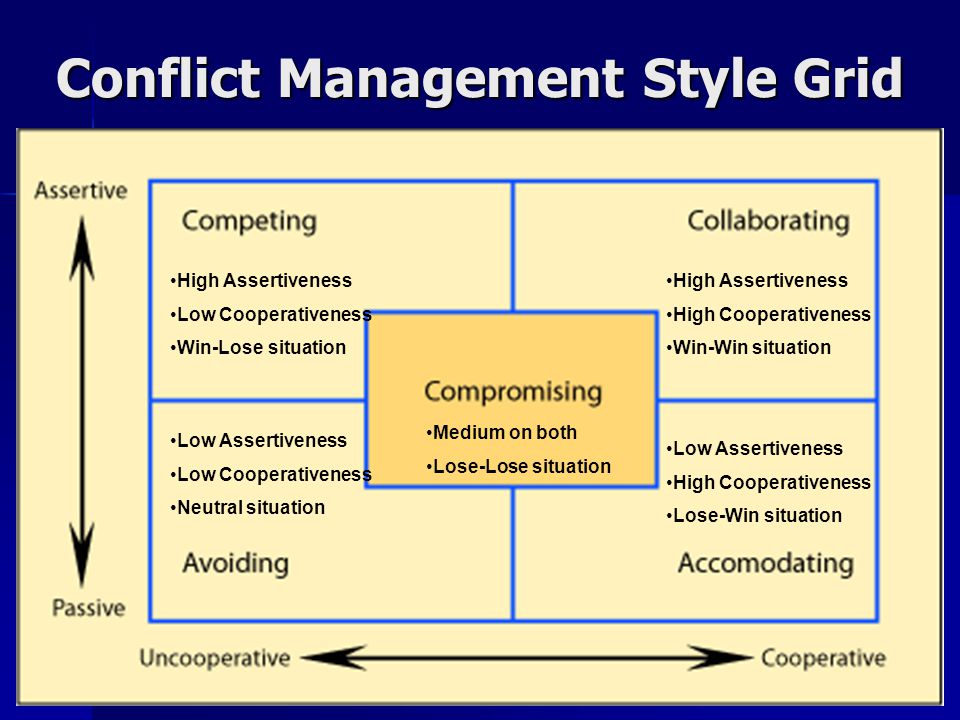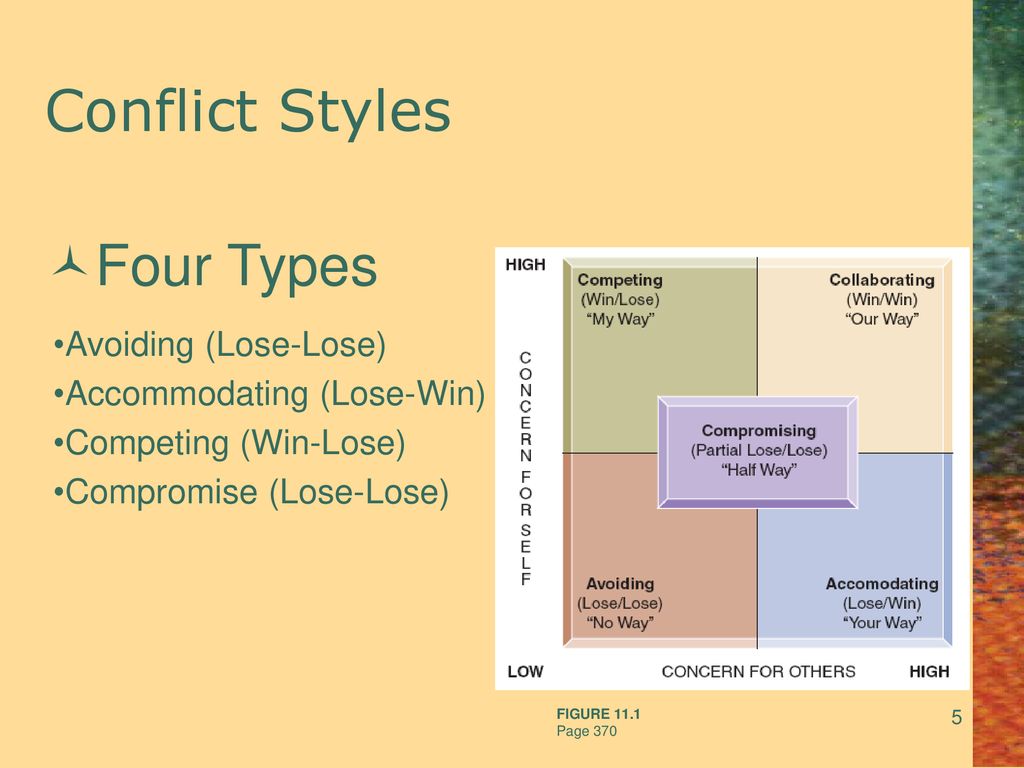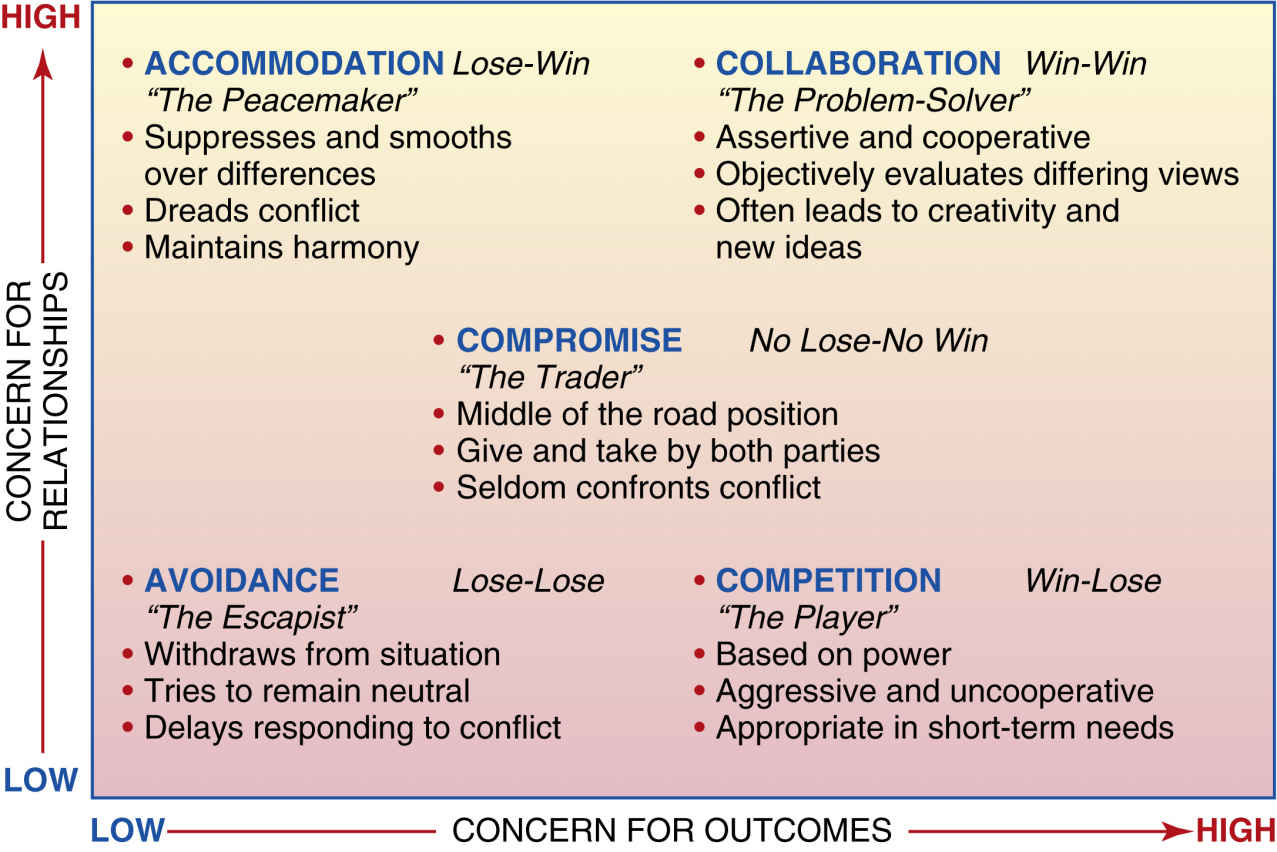Disadvantage Conflicts remain. Harmonizing or Accommodating Style.

The 5 Styles Of Conflict Management
Parties using this style often take legal action to resolve conflicts.

. People have different styles. The conflict style profiles developed by Kenneth W. Take time to genuinely observe and listen before using your power or position of authority to resolve conflict.
It puts parties in a winlose relationship where one attempts to achieve hisher goals at. People who usually decide to use this conflict resolution strategy are normally highly power-driven individuals. Intermediate in both assertiveness and cooperativeness Find an acceptable settlement that only partially satisfies your concerns and those of your teammates.
Unassertive and uncooperative Side step the conflict without trying to satisfy. This means that the other party involved is of no or very little concern. Those using a competitive style tend to seek control over a discussion in both substance and ground rules.
Thomas and Ralph H. Win-win win-lose and lose-lose are game theory terms that refer to the possible outcomes of a game or dispute involving two sides and more importantly how each side perceives their outcome relative to their standing before the game. Thomas and Ralph H.
The conflict style profiles developed by Kenneth W. We require or need and never reward bullies. For accommodating style negotiators the relationship is everything.
Hard influence tactic Highly goal-oriented. Involves high concern for self and low concern for others. Competing style people need to work on awareness empathy and compassion.
The conflict style profiles portray competing as a power driven mode being high in assertiveness and low in cooperativeness. Conflict can happen when youre competing over scarce resources. Win-lose scenarios are sometimes necessary in a home when decisions or boundaries are needing to be made but look out for pride and selfishness that may be driving this style.
Can sometimes enhance a relationship. Advantage This may help to maintain relationships that would be hurt by conflict resolution. Parties using this style are incapable of coming to an agreement.
Competing tends to result in responses that increase the level of threat. Turtles tend to give up personal goals and display passive behavior. Occurs when people perceive a situation as being an either-or one.
Your thinking style or communication style might conflict with somebody elses thinking style or their communication style. Parties using this style often see conflicts as winlose scenarios. UNIT 1 MILESTONE 1 1 Which of the following statements about the competing conflict style is true.
A competing style is one in which the concerns and the position of the opposition are completely ignored. The opposition is completely ignored. Restate your position firmly using strong language not wed like or want but rather.
The goal is to win. These conflicts can be won by any way seen fit ie. The competing style is used when a.
This creates lose-lose situations. A competingwin-lose conflict style A. Kilmann portray competing as a power driven mode being high in assertiveness and low in cooperativeness.
Sometimes you will find conflict in values. This style of conflict is another unhealthy type of conflict in which a person acts in a non-assertive manner. Threatening and intimidating Advantage.
The conflict can be won by any means necessary. Relationships take on a lower priority and do not hesitate to use aggressive behavior to resolve conflicts Sharks can be autocratic authoritative and uncooperative. The good news is that conflicts in styles are easy to adapt to when you know how.
Competition winlose This method of conflict resolution pits two entities against one another and is heavily competitive. Parties using this style rely on physical force to. Accommodating also known as smoothing is the opposite of competing.
Turtles desire to ignore conflict leads them to be uncooperative and unassertive. It puts parties in a winlose relationship where one attempts to achieve hisher goals at the expense of another. Involves high concern for self and low concern for others.
How do you practice competing conflict style. Argument rank position or authority or a political exercise of power. The competing conflict style is considered as a win-lose approach.
Conflict Management Styles CMS The Competing Shark win-lose. Can sometimes enhance a relationship. Has a distinguishing characteristic of power.
It puts parties in a winlose relationship where one attempts to achieve hisher goals at. They fear that loss of such control will result in solutions that fail to meet their needs. Argument of ideas pulling rank or using leverage you may have.
This style of conflict is very one-sided. Find a winwin solution that completely satisfies both your concerns and your teammates concerns. A competingwin-lose conflict style.
Cooperating or Collaborating Style. Accommodate I Lose - You Win The opposite of competing. Competitive conflict systems sometimes also termed positional distributive winlose or adversarial are grounded in a winlose perspectivefor one party to win the other party must lose Competitive systems often assume a zero-sum or fixed-pie view of all resources.
Winning the argument is the only metric and any concession to the other side is seen as a sign of weakness. The competing style is also frequently practiced as an assertive way to achieve goals within the. Turtles would rather hide and ignore conflict than resolve it.
If the sharks decision is correct a better decision without compromise. A competitive style negotiator will see you as weak and come back for more. Has a distinguishing characteristic of power.
Occurs when people perceive a situation as being an either-or one. The Five Conflict Styles ThomasKillman 1972 with further descriptions and analysis by Bonnie Burrell 2001 The Competing Style is when you stress your position without considering opposing points of view. This is used as a strategic approach as a means of gaining power and control.
Five Different Types of Conflict Styles Competing or Directing Style. For example a win results when the outcome of a negotiation is better than expected a loss when the outcome is worse than. This style is highly assertive with minimal cooperativeness.
Kilmann portray competing as a power driven mode being high in assertiveness and low in cooperativeness.

Looking Out Looking In Fourteenth Edition 11 Managing Interpersonal Conflicts Chapter Topics The Nature Of Conflict Conflict Styles Conflict In Relational Ppt Download

Which Animal Embodies You Most Ppt Video Online Download

Managing Interpersonal Conflicts Ppt Download

Managing Conflict Working Together To Achieve Win Win Solutions By Mary Mahoney Medium


0 comments
Post a Comment